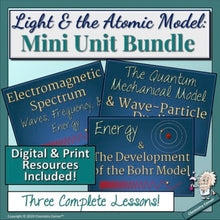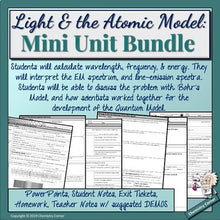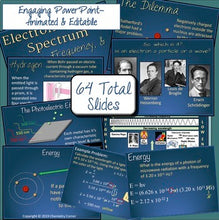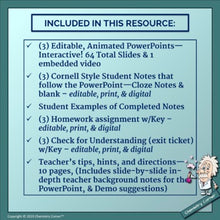These lessons are not sold separately because each lesson depends on the previous lesson.
The purpose of the unit is to understand how scientists discovered the structure of the atom as we know it today. Otherwise, it will be confusing to students as to why we are stopping in the middle of everything and studying light, the EM spectrum, and calculating wavelengths and frequency! So, essentially, we are traveling down the same road as these scientists did. We are encountering their problems, and working through solutions along with them as we move through the evolution of the modern atomic structure.
Overarching Concept for the Unit: The story of the development of our current atomic model. We begin with Rutherford’s dilemma and continue through to the Quantum Mechanical Atomic Model. Along the way, scientists struggle to understand natural phenomena and what it can contribute to the understanding of the atom. Students will study as the scientists did –The Electromagnetic Spectrum, waves, frequency, and energy as it relates to the development of the Bohr Model. Students will tune in to the argument of whether an electron is a particle or a wave. Finally, ending with our current atomic model.
Light & The Atomic Model Mini Unit Bundle includes these OBJECTIVES:
-
Describe the problem with Rutherford’s Model and how Bohr begins his quest to solve the problem.
-
Define electromagnetic radiation, and the electromagnetic spectrum
-
Read the electromagnetic spectrum stating the relationships between waves, frequency, and energy
-
Solve wavelength and frequency problems
-
Discuss the significance of the photoelectric effect, Planck, and Einstein’s work to the development of the atomic model.
-
Describe the dual wave-particle nature of light.
-
Describe line-emission spectrum, and its relationship to the development of Bohr’s model.
-
Discuss the development of Bohr’s atomic model, and problems with the model.
-
Discuss de Broglie’s role in the development of the quantum model of the atom.
-
Describe the Heisenberg Uncertainty Principle.
-
Explain how the Heisenberg Uncertainty Principle and the Schrödinger wave equation led to the idea of atomic orbitals, and the quantum model.
-
Compare and contrast the Bohr model and the quantum model of the atom.
NGSS:
HS-PS4-3: Evaluate the claims, evidence, and reasoning behind the idea that electromagnetic radiation can be described either by a wave model or a particle model, and that for some situations one model is more useful than the other.
DCI: PS4.B: Electromagnetic radiation (e.g., radio, microwaves, light) can be modeled as a wave of changing electric and magnetic fields or as particles called photons. The wave model is useful for explaining many features of electromagnetic radiation, and the particle model explains other features.
SEP: Science Models, Laws, Mechanisms, & Theories Explain Natural Phenomena
Crosscutting concepts: System & System Models
Models can be used to simulate systems and interactions (energy & matter)
HS-PS4-1: Use mathematical representations to support a claim regarding relationships among the frequency, wavelength, and speed of waves.
DCI: PS4.A: The wavelength and frequency of a wave are related to one another by the speed of travel of the wave, which depends on the type of wave and the medium through which it is passing.
SEP: Developing and using models & Using mathematics and computational thinking
Crosscutting concepts: Cause & Effect
Empirical evidence is required to differentiate between cause and correlation and make claims about specific causes and effects
Products Included in This Mini Bundle:
Note: each lesson consists of a editable PowerPoint, Student Notes (Cornell Style), detailed Teacher Notes with demonstration suggestions, Exit Ticket, and a Homework /Practice Assignment
Lesson: The Electromagnetic Spectrum, Waves, Frequency, and Energy
Lesson: Energy & The Development of the Bohr Model
Lesson: The Quantum Mechanical Model of the Atom
Free Bonuses:
Mini Unit Study Guide – pdf & editable copy
Mini Unit Test – pdf & editable copy
Note: The PowerPoints included in this bundle are editable, animated PowerPoints. This means that slides will appear to be busy and even overlapping in the “slide” mode, but will be awesome in the “slide show” mode. Please don’t edit the PowerPoint until you have watched it in slide show mode.
Included in This Product:
* (3) Animated PowerPoints- Editable- 64 Total Slides & 1 embedded video
* (3) Student Notes- Cornell Style Cloze Notes w/Example KEYs - editable, print, & digital
* (3) Homework Assignments w/KEYS (Standard & Honors for Phase Change Lesson) - editable, print, & digital
* (3) Check for Understanding (Exit Tickets) w/KEYS - editable, print, & digital
* (3) Teacher Notes slide by slide, tips, and strategies. (11 pages)
* Unit Study Guide—Editable w/ KEY
* Unit Test–Editable w/ KEY
Prior Knowledge:
Basic knowledge of atomic structure, and the development of the atomic model - at least through Rutherford.
This BUNDLE will be a something you will want to use year after year and SAVE you money, too!
This lesson is appropriate for grades 9-12 chemistry or physical science.
Chemistry Corner
*********************************************************************************
You may also be interested in these included products:
High School Chemistry Year Curriculum
Chemistry Doodle Notes for the Year: A Growing Bundle
Chemistry BellWork/WarmUps Editable- For the Entire Year
*********************************************************************************
Note: Chemistry Corner’s PowerPoints are perfect for the flipped classroom. However, please read the Copyright Terms below before using it as such. Thanks!
LICENSING TERMS: By downloading this product, you own a license for one teacher only for personal use in your classroom. Licenses are non-transferable, meaning they cannot be passed from one teacher to another. No part of this resource is to be shared with colleagues or used by an entire grade level, school, or district without purchasing the proper number of licenses. I you are a coach, principal or district interested in transferable licenses to accommodate yearly staff changes, please contact Chemistry Corner.
COPYRIGHT TERMS: ©Chemistry Corner. Please note – all material included in this resource belongs to Chemistry Corner. By downloading, you have a license to use the material, but you do not own the material. This resource, or any portion of this resource, may not be uploaded to the internet in any form, including classroom/personal websites or network drives, unless the site is password protected and can only be accessed by students—no other teachers or anyone else on the internet.








